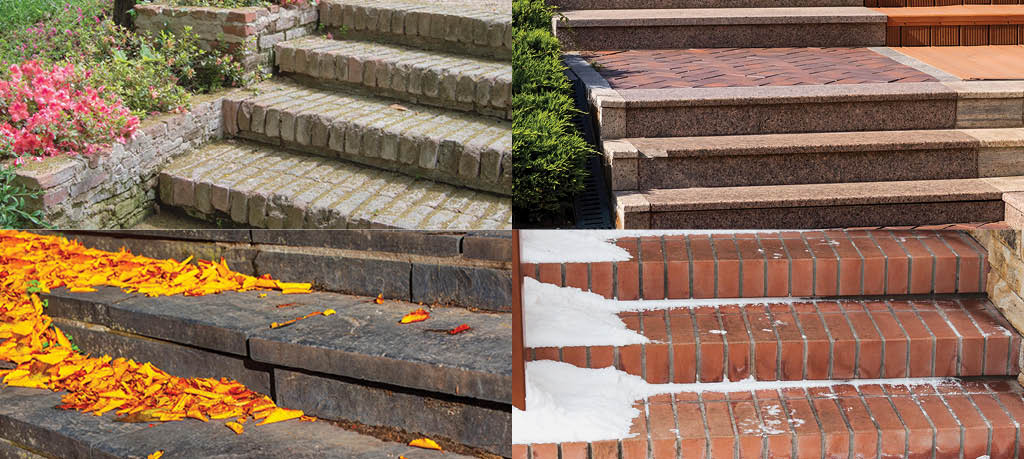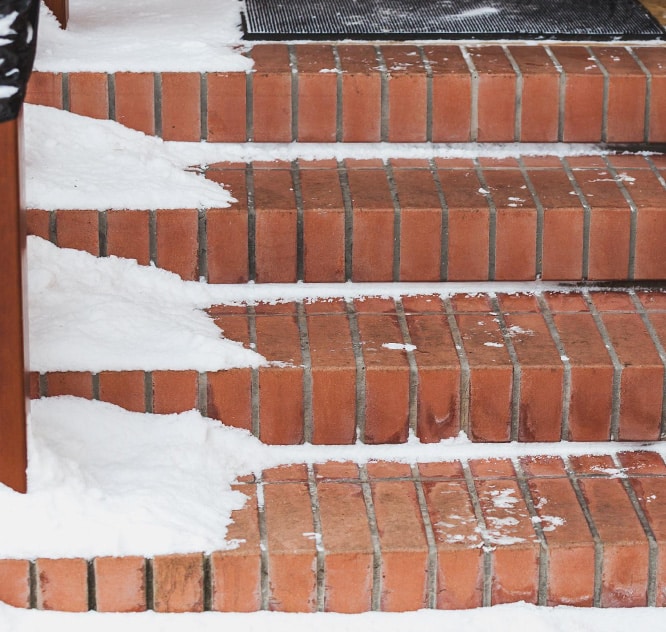
Brick steps are a timeless feature of many homes, valued for their rustic texture and rich, earthy tones. But while brick is durable, it comes with a hidden challenge: porosity. During the firing process, clay bricks form microscopic voids that absorb moisture. This absorption invites moss and algae to grow, making the brick steps slippery. In colder climates, that moisture can freeze and expand, leading to cracks and surface chipping (a process called freeze–thaw spalling).
For homeowners, this means that brick step maintenance is a year-round responsibility. By taking seasonal steps to clean, seal, and protect your stairs, you can keep them structurally sound, visually appealing, and most importantly, prevent slippery brick steps. This guide provides a practical seasonal plan, along with DIY-friendly products and permanent safety solutions like HandiTreads aluminum stair treads and nosings, to ensure your stairs stay safe through every season.
Winter leaves behind more than snow. Moisture, debris, and freezing cycles often set the stage for slippery growth and structural wear. Spring is the time for a reset.
The first priority is removing dirt, moss, and algae that thrive in damp conditions. Power washing is effective, but use the lowest pressure possible and a wide-angle nozzle to avoid damaging mortar or forcing water deeper into cracks.

For a gentler approach, try these DIY cleaning methods:
Rinse well after all of these measures, and by removing this buildup, you will restore traction to your brick stairs and prevent slippery conditions from worsening.
After cleaning, check for cracks, spalling (flaking), or loose bricks caused by freeze–thaw cycles. Mortar that crumbles or leaves gaps should be repointed (refilled with new mortar) to prevent further water intrusion. Reset any wobbly bricks on fresh mortar to keep the surface even and safe to walk on. Addressing these repairs early ensures your stairs remain structurally sound before heavy spring rains.
Summer’s warm, dry weather is the perfect time to protect your brick steps from moisture and prepare them for the seasons ahead.
Because bricks are porous, sealing is one of the best ways to extend their lifespan and reduce slipperiness.

There are two main types of sealers:
For most homeowners, a penetrating sealer is the safest choice for sealing brick stairs. It blocks moisture without altering appearance or creating a slip hazard. Apply after a thorough cleaning and allow at least 24–48 hours of dry weather for curing.
Summer is also the right time to improve both safety and durability by addressing step edges. HandiTreads Aluminum Nosings are designed to wrap over the front edge of each step, providing traction exactly where slips are most likely to occur.
Made from rust-proof aluminum, these nosings feature a patented raised-button surface that grips shoes even in rain. The forward lip covers worn or cracked edges, effectively repairing damage while adding slip resistance. Unlike temporary fixes, nosings also improve the structural integrity of crumbling or splintering steps, extending their lifespan. They come in three widths (2.75”, 6″ and 9″) to cover more of each stair tread, offering maximum traction on high-risk surfaces.
Available in four refined finishes (Java Brown, Chestnut Brown, New England Gray, and Obsidian Black), they blend seamlessly with brick or create a subtle contrast. Easy to install with screws or masonry anchors, HandiTreads Nosings are a cost-effective, permanent solution that enhances both safety and appearance.
By combining sealing and nosings in summer, you extend the life of your brick stairs and make them safer before the slippery months return.
Fall introduces new challenges: falling leaves, frequent rain, and shorter daylight hours. Each adds risk to brick stairs if left unchecked.
Fall introduces new challenges: falling leaves, frequent rain, and shorter daylight hours. Each adds risk to brick stairs if left unchecked.

Wet leaves on steps are nearly as hazardous as ice. Sweep them off regularly to prevent buildup and staining. Leaves trap moisture against the bricks, creating ideal conditions for moss and algae. If you notice green patches, clean them promptly with a scrub brush or mild algaecide solution. Also, ensure gutters and downspouts are directing water away from your stairs to prevent puddles.
Fall is the best time to upgrade your stairs with permanent anti-slip protection before winter arrives. HandiTreads Aluminum Treads are one of the most durable solutions available.
These treads attach securely to the surface of each brick step and feature a patented raised-button surface that self-cleans with every step, dispersing water, snow, and even up to an inch of slush. The result is instant traction in any direction, even in icy or wet weather. Unlike rubber mats or grit tape, which wear out, peel, or shift over time, HandiTreads are maintenance-free and built from rust-proof, high-grade aluminum. They’re also flush enough to be safely used with mobility aids such as wheelchairs, walkers, and strollers, making them inclusive for all users.
Available in multiple lengths (30″, 36″, and 48″) and four earth-toned finishes, the anti-slip treads enhance rather than detract from your home’s exterior. Proudly made in the USA and backed by a lifetime residential warranty, HandiTreads Non-Slip Aluminum Treads are proven in thousands of installations nationwide as a permanent, all-weather safety upgrade.
Other temporary solutions like grit paint, adhesive tape, or rubber mats may provide short-term help but take a lot of surface preparation, require frequent replacement and can create new hazards if they peel or shift. Aluminum treads, by contrast, provide long-term peace of mind without reapplication.
Pairing HandiTreads with good outdoor lighting also helps. Replace burned-out bulbs and consider motion-activated or solar stair lights to improve visibility during shorter autumn days.
Winter is the most demanding season for brick stairs. Ice, snow, and long nights all raise the risk of slips.
Remove snow promptly before it compacts into ice. Use a plastic shovel or broom to avoid scratching bricks. When ice forms, avoid rock salt (sodium chloride), which damages masonry.

Safer alternatives include:
Avoid deicers (ice-melting products) with ammonium nitrates or sulfates, which aggressively damage brick. After winter, rinse off residues to protect your stairs and landscaping.
Winter is the time to rely on the permanent safety upgrades you installed earlier. HandiTreads and nosings continue to provide traction even in snow. Make sure your handrail is secure, as it provides critical support when surfaces are slick. Adding step lights or motion-activated lighting ensures safe passage during dark winter evenings. Temporary mats can be used in severe weather, but remember to secure them and remove them promptly once conditions improve.
Brick steps combine beauty with strength, but they demand regular care to stay safe and attractive. By following a seasonal maintenance routine—cleaning and repairing in spring, sealing and reinforcing in summer, clearing and lighting in fall, and deicing and protecting in winter—you can preserve your stairs for years to come.
While cleaning and sealing are essential, permanent solutions like HandiTreads Aluminum Nosings and Aluminum Treads provide year-round traction without the need for constant reapplication. Together, these steps ensure your brick stairs remain both welcoming and slip-free in every season.